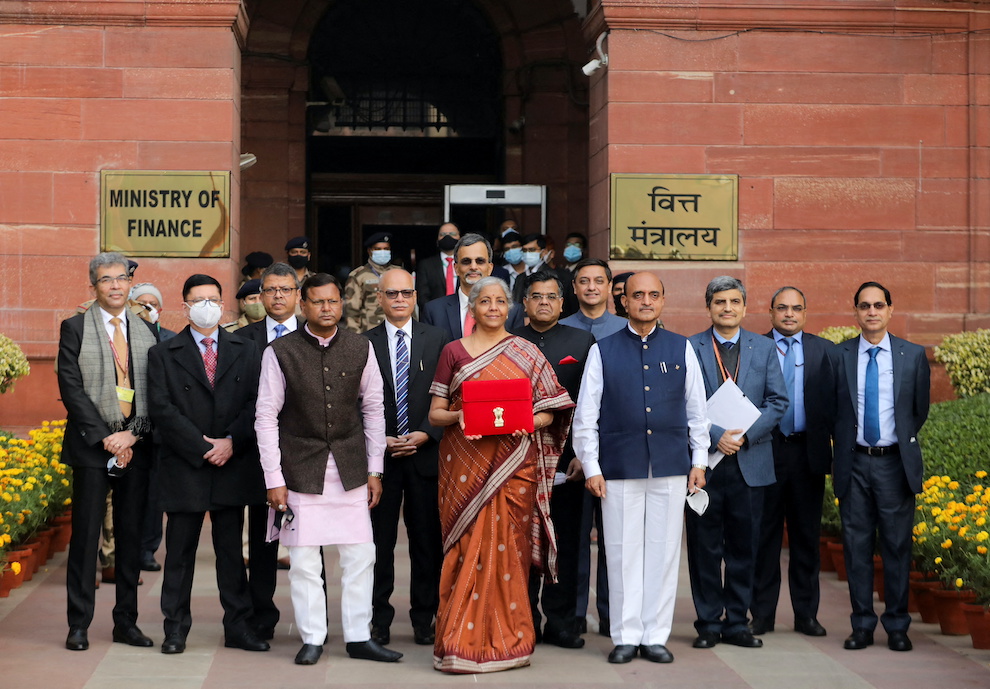India unveiled a bigger budget on Tuesday of 39.45 trillion rupee ($529.7 billion) for the coming fiscal year, stepping up investment on highways and affordable housing to put growth on a firmer footing as the economy recovers from the pandemic.
The government has projected GDP growth at 8% to 8.5% compared with an estimated 9.2% for the current fiscal year and a 6.6% contraction the previous year.
“The overall sharp rebound and recovery of the economy is reflective of our country’s strong resilience,” Finance Minister Nirmala Sitharaman said, vowing to lay the foundation for faster growth.
She announced spending of 200 billion rupees ($2.68 billion) for a highway expansion programme and said 400 new trains would be manufactured over the next three years. Total government spending will be 4.6% more than the current year.
The fiscal deficit for the current year would be 6.9% of GDP, slightly more than the 6.8% targeted earlier, Sitharaman said.
For the next fiscal year, India is targeting a deficit of 6.4% of GDP, hoping to build on higher tax revenues and privatisation of state firms including a share sale of giant insurer Life Insurance Corporation.
Prime Minister Narendra Modi’s government has made building of physical and digital infrastructure a top priority to improve the cost of doing business.
“The touchstone of the master plan will be world-class, modern infrastructure and logistics synergy among different modes of movement of both people and goods, and location of projects,” Sitharaman said.
Digital Rupee, Crypto Tax
She said the Reserve Bank of India would introduce a digital currency in the next fiscal year using blockchain and other supporting technology.
“Introduction of a central bank digital currency will give a big boost to the digital economy. A digital currency will also lead to a more efficient and cheaper currency management system,” Sitharaman said.
The RBI has already announced that it has worked out a plan for phased implementation of a central bank digital currency to avoid any disruptions, after examining what other countries are doing.
But the central bank has voiced “serious concerns” around private cryptocurrencies on the grounds that these may cause financial instability.
That led to the minister announcing that any income on virtual digital assets should be taxed at a high rate – something that will not please the 15-20 million Indians believed to have invested in cryptocurrencies.
Sitharaman said: “There has been a phenomenal increase in transactions in virtual digital assets. The magnitude and frequency of these transactions have made it imperative to provide for a specific tax regime. Accordingly, for the taxation of virtual digital assets, I propose to provide that any income from transfer of any virtual digital asset shall be taxed at the rate of 30%.
“No deduction in respect of any expenditure or allowance shall be allowed while computing such income except cost of acquisition. Further, loss from transfer of virtual digital asset cannot be set off against any other income.”
Solar Power, EV Battery Swapping
Sitharaman said an additional 195 billion rupees ($2.62 billion) would be allocated for production-linked incentives toward the manufacturing of “high-efficiency” solar power modules – to help the government meet its ambitious goal of 280 GW of installed solar capacity by 2030.
The government also plans to introduce a new policy for battery swapping to encourage the use of electric vehicles and achieve its broader decarbonisation goals, she said.
“Considering the constraint of space in urban areas for setting up charging stations, battery swapping policy will be brought out and interoperability standards will be formalised,” the minister said.
India’s Reliance Industries and Britain’s BP have formed a joint venture for battery swapping in the country, as have Indian motorbike maker Hero MotoCorp and Taiwan’s Gogoro.
Shares of Indian battery makers Amara Raja Batteries and Exide Industries rose about 2% after the announcement. Indeed, most shares rose in the run-up to the federal budget on expectations of greater public spending.
Concerns, though, have risen about inflation and loss of tens of thousands of jobs because of the disruptions caused by the pandemic.
Sitharaman expressed empathy with those who had to bear adverse health and economic affects of Covid-19 that devastated India during the second wave last year.
A government report on Monday warned that growing risks of global inflation led by rising crude oil prices could hit the economy.
• Reuters with Jim Pollard and Indrajit Basu
This report was updated on February 1, 2022 with further details.
ALSO ON AF:
India Set to be World’s Fastest Growing Big Economy in 2022
Omicron in Community Transmission Stage in India – ToI
New Era for Cryptocurrency In India: Explainer
India to consider digital currency use





















